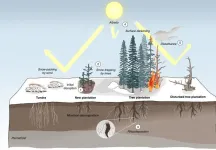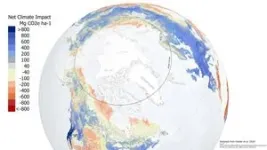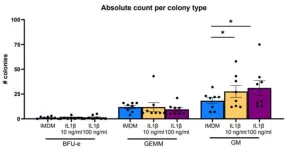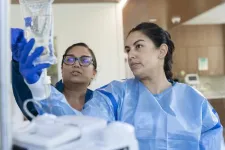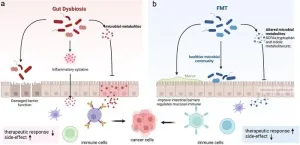(Press-News.org) Tree planting has been widely touted as a cost-effective way of reducing global warming, due to trees’ ability to store large quantities of carbon from the atmosphere. But, writing in the journal Nature Geoscience, an international group of scientists argue that tree planting at high latitudes will accelerate, rather than decelerate, global warming.
As the climate continues to warm, trees can be planted further and further north, and large-scale tree-planting projects in the Arctic have been championed by governments and corporations as a way to mitigate the worst effects of climate change.
However, when trees are planted in the wrong places - such as normally treeless tundra and mires, as well as large areas of the boreal forest with relatively open tree canopies - they can make global warming worse.
According to lead author Assistant Professor Jeppe Kristensen from Aarhus University in Denmark, the unique characteristics of Arctic and sub-Arctic ecosystems make them poorly suited for tree planting for climate mitigation.
“Soils in the Arctic store more carbon than all vegetation on Earth,” said Kristensen. “These soils are vulnerable to disturbances, such as cultivation for forestry or agriculture, but also the penetration of tree roots. The semi-continuous daylight during the spring and early summer, when snow is still on the ground, also makes the energy balance in this region extremely sensitive to surface darkening, since green and brown trees will soak up more heat from the sun than white snow.”
In addition, the regions surrounding the North Pole in North America, Asia and Scandinavia are prone to natural disturbances - such as wildfires and droughts - that kill off vegetation. Climate change makes these disturbances both more frequent and more severe.
“This is a risky place to be a tree, particularly as part of a homogeneous plantation that is more vulnerable to such disturbances,” said Kristensen. “The carbon stored in these trees risks fueling disturbances and getting released back to the atmosphere within a few decades.”
The researchers say that tree planting at high latitudes is a prime example of a climate solution with a desired effect in one context but the opposite effect in another.
“The climate debate is very carbon-focused, because the main way humans have modified the Earth’s climate in the last century is through emitting greenhouse gases from burning fossil fuels,” said Kristensen. “But at the core, climate change is the result of how much solar energy entering the atmosphere stays, and how much leaves again – Earth’s so-called energy balance.”
Greenhouse gases are one important determinant of how much heat can escape our planet’s atmosphere. However, the researchers say that at high latitudes, how much sunlight is reflected back into space, without being converted into heat (known as the albedo effect), is more important than carbon storage for the total energy balance.
The researchers are calling for a more holistic view of ecosystems to identify truly meaningful nature-based solutions that do not compromise the overall goal: slowing down climate change.
“A holistic approach is not just a richer way of looking at the climate effects of nature-based solutions, but it’s imperative if we’re going to make a difference in the real world,” said senior author Professor Marc Macias-Fauria, from the University of Cambridge’s Scott Polar Research Institute.
However, the researchers recognise that there can be other reasons for planting trees, such as timber self-sufficiency, but these cases do not come with bonuses for climate mitigation.
“Forestry in the far North should be viewed like any other production system and compensate for its negative impact on the climate and biodiversity,” said Macias-Fauria. “You can’t have your cake and eat it, and you can’t deceive the Earth. By selling northern afforestation as a climate solution, we’re only fooling ourselves.”
So how can we moderate global warming at high latitudes? The researchers suggest that working with local communities to support sustainable populations of large herbivores, such as caribou, could be a more viable nature-based solution to climate change in Arctic and subarctic regions than planting millions of trees.
“There is ample evidence that large herbivores affect plant communities and snow conditions in ways that result in net cooling,” said Macias-Fauria. “This happens both directly, by keeping tundra landscapes open, and indirectly, through the effects of herbivore winter foraging, where they modify the snow and decrease its insulation capacity, reducing soil temperatures and permafrost thaw.”
The researchers say it’s vital to consider biodiversity and the livelihoods of local communities in the pursuit of nature-based climate solutions.
“Large herbivores can reduce climate-driven biodiversity loss in Arctic ecosystems and remain a fundamental food resource for local communities,” said Macias-Fauria. “Biodiversity and local communities are not an added benefit to nature-based solutions: they are fundamental. Any nature-based solutions must be led by the communities who live at the frontline of climate change.”
END
Planting trees in the Arctic could make global warming worse, not better, say scientists
An international group of scientists argue that tree planting at high latitudes will accelerate, rather than decelerate, global warming.
2024-11-07
ELSE PRESS RELEASES FROM THIS DATE:
Finding function for noncoding RNAs using a new kind of CRISPR
2024-11-07
Genes contain instructions for making proteins, and a central dogma of biology is that this information flows from DNA to RNA to proteins. But only two percent of the human genome actually encodes proteins; the function of the remaining 98 percent remains largely unknown.
One pressing problem in human genetics is to understand what these regions of the genome do—if anything at all. Historically, some have even referred to these regions as “junk.”
Now, a new study in Cell finds that some noncoding RNAs are not, in fact, junk—they are functional and play an important role in our cells, including in cancer and human development. Using CRISPR technology that ...
Neurodevelopment in the first 2 years of life following prenatal exposure to maternal SARS-CoV-2 Infection
2024-11-07
About The Study: In this longitudinal cohort study of multiple aspects of child neurodevelopment between ages 6 and 24 months, negligible associations between prenatal exposure to SARS-CoV-2 infection and child outcomes were observed. Follow-up research is warranted to determine whether these predominantly null effects persist into later childhood.
Corresponding Author: To contact the corresponding author, Gerald F. Giesbrecht, PhD, email ggiesbre@ucalgary.ca.
To access the embargoed study: Visit our For The Media website at this link https://media.jamanetwork.com/
(doi:10.1001/jamanetworkopen.2024.43697)
Editor’s ...
Racial disparities in genetic detection rates for inherited retinal diseases
2024-11-07
About The Study: Results from this study highlight a lower genetic detection rate for Black patients than for white patients with inherited retinal diseases. This supports a concern that the current development of inherited retinal disease therapeutics is highly dependent on the ability to identify the genetic cause of disease.
Corresponding Author: To contact the corresponding author, K. Thiran Jayasundera, M.D., email thiran@med.umich.edu.
To access the embargoed study: Visit our For The Media website at this link https://media.jamanetwork.com/
(doi:10.1001/jamaophthalmol.2024.4696)
Editor’s Note: Please see the article for additional information, including ...
Stem cells shed insight into cardiovascular disease processes
2024-11-07
When thinking about the immune system, most people think about B and T cells and how they can be trained to recognize pathogens, preventing re-infections. Besides this “adaptive” immune system, we also have an “innate” immune system which acts as first line defense against e.g. bacteria and viruses. The textbook view is that the innate immune system is non-specific so that it’s response always follows the same pattern, even for recurring infections. However, research published today in Stem Cell Reports provides evidence ...
New study: Plastics pollution worsen the impacts of all Planetary Boundaries
2024-11-07
“It’s necessary to consider the full life cycle of plastics, starting from the extraction of fossil fuel and the primary plastic polymer production” says lead article writer Patricia Villarrubia-Gómez at Stockholm Resilience Centre.
Plastics are not as safe and inert as previously thought. The new research article written by an international team of researchers uses the planetary boundaries framework to structure the rapidly mounting evidence of the effects of plastics on the environment, health and human wellbeing.
500 million tons of plastics are now produced yearly but only nine percent get recycled globally. Plastics are everywhere: ...
Long-term risks from prostate cancer treatment detailed in new report
2024-11-07
The risks of adverse effects and complications from treatment for prostate cancer are substantial and continue for years after treatment ends. The largest comprehensive analysis reporting long-term risks from such treatment relative to the risks faced by a control group of untreated men has just been published in the journal JAMA Oncology.
In the 12 years following treatment, men whose initial treatment was a prostatectomy (removal of all or part of the prostate) had a risk of urinary or sexual complications ...
Does more virtual care mean more low-value care? Study suggests no
2024-11-07
Before 2024 ends, Congress will decide whether to keep or change rules about telehealth, or let them expire. And even though the decision will focus on Medicare’s payment for virtual patient care, it will likely impact telehealth access for people with other kinds of health insurance too.
Now, a new University of Michigan study suggests that policymakers can rest easier about one of the top worries about telehealth: that virtual care will drive up the use of tests and scans that patients don’t need, wasting money and resources.
In fact, the study shows that low-value care didn’t rise faster at primary care practices that used telehealth the most, compared with those ...
City of Hope Research Spotlight, October 2024
2024-11-07
City of Hope® Research Spotlight offers a glimpse at groundbreaking scientific and clinical discoveries advancing lifesaving cures for patients with cancer, diabetes and other chronic, life-threatening diseases. Each spotlight features research-related news such as recognitions, collaborations and the latest research defining the future of medical treatment.
This roundup highlights the biology behind our sense of smell, real-world data that can be used to refine esophageal cancer treatment guidelines, a potential new approach to treating patients with type 2 diabetes, a new way to target pancreatic cancer ...
Increased focus on comorbidities, socioeconomic factors would help improve health equity for people with COPD
2024-11-07
Miami (November 7, 2024) – Health care providers treating people with COPD also need to focus on the person’s socioeconomic factors, along with considering their additional health conditions or comorbidities, according to a new article. The article is published in the September 2024 issue of Chronic Obstructive Pulmonary Diseases: Journal of the COPD Foundation, a peer-reviewed, open-access journal.
Chronic obstructive pulmonary disease (COPD) is an inflammatory lung disease, comprising several conditions, including chronic bronchitis and emphysema, and can be caused by genetics ...
Gut dysbiosis and fecal microbiota transplantation in pancreatic cancer: Current status and perspectives
2024-11-07
Pancreatic ductal adenocarcinoma (PDAC) is recognized as one of the most lethal cancers, with an estimated five-year survival rate of approximately 10%. This poor prognosis is largely attributed to the challenges in early diagnosis, aggressive tumor biology, and limited treatment options. Most PDAC cases are diagnosed at advanced stages due to its typically asymptomatic onset, making only a small percentage of patients eligible for potentially curative surgical resection. In recent years, increasing attention has been paid to the role of gut microbiota dysbiosis in PDAC, as ...
LAST 30 PRESS RELEASES:
Artificial saliva containing sugarcane protein helps protect the teeth of patients with head and neck cancer
Understanding the role of linear ubiquitination in T-tubule biogenesis
Researchers identify urban atmosphere as primary reservoir of microplastics
World’s oldest arrow poison – 60,000-year-old traces reveal early advanced hunting techniques
Bristol scientists discover early sponges were soft
New study uncovers how rice viruses manipulate plant defenses to protect insect vectors
NSF–DOE Vera C. Rubin Observatory spots record-breaking asteroid in pre-survey observations
Ribosomal engineering creates “super-probiotic” bacteria
This self-powered eye tracker harnesses energy from blinking and is as comfortable as everyday glasses
Adverse prenatal exposures linked to higher rates of mental health issues, brain changes in adolescents
Restoring mitochondria shows promise for treating chronic nerve pain
Nature study identifies a molecular switch that controls transitions between single-celled and multicellular forms
USU chemists' CRISPR discovery could lead to single diagnostic test for COVID, flu, RSV
Early hominins from Morocco reveal an African lineage near the root of Homo sapiens
Small chimps, big risks: What chimps show us about our own behavior
We finally know how the most common types of planets are created
Thirty-year risk of cardiovascular disease among healthy women according to clinical thresholds of lipoprotein(a)
Yoga for opioid withdrawal and autonomic regulation
Gene therapy ‘switch’ may offer non-addictive pain relief
Study shows your genes determine how fast your DNA mutates with age
Common brain parasite can infect your immune cells. Here's why that's probably OK
International experts connect infections and aging through cellular senescence
An AI–DFT integrated framework accelerates materials discovery and design
Twist to reshape, shift to transform: Bilayer structure enables multifunctional imaging
CUNY Graduate Center and its academic partners awarded more than $1M by Google.org to advance statewide AI education through the Empire AI consortium
Mount Sinai Health system receives $8.5 million NIH grant renewal to advance research on long-term outcomes in children with congenital heart disease
Researchers develop treatment for advanced prostate cancer that could eliminate severe side effects
Keck Medicine of USC names Christian Pass chief financial officer
Inflatable fabric robotic arm picks apples
MD Anderson and SOPHiA GENETICS announce strategic collaboration to accelerate AI-driven precision oncology
[Press-News.org] Planting trees in the Arctic could make global warming worse, not better, say scientistsAn international group of scientists argue that tree planting at high latitudes will accelerate, rather than decelerate, global warming.
